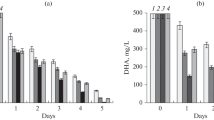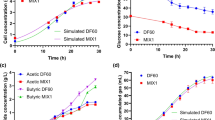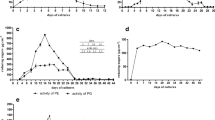Abstract
Carbazole (CA) is a heterocyclic nitrogen compound contained in the crude petroleum oil and recalcitrant to removal through the refinery processes. For development of the efficient CA-degradation bioprocess, conditions for the recycle use of Sphingomonas sp. CDH-7 resting cells were examined. When the resting cells (O.D.660 3.3) were shaken in 50 mM K2HPO4-KH2PO4 buffer (pH 7.0) containing CA 1000 mg/L, CA 880 mg/L was degraded within 3 h, but thereafter the activity decreased markedly. However, the activity was found to be restored to the initial level after the shaking treatment for 3 h in CA-free medium solution or in the buffer containing 20 mM MgCl2. Although the CA-degradation activity of CDH-7 resting cells was lost after 3 h of shaking in the buffer containing 100 mM EDTA, it was restored through the shaking treatment for 3 h in the buffer containing 20 mM MgCl2. When CA was periodically added eight times at a concentration of 100 mg/L (0.599 mM) to the reaction mixture containing the resting cells, CA 778 mg/L (4.66 mM) was continuously degraded within 35 h by the recycle use of resting cells, with the restoration treatment after each CA-degradation reaction by the resting cells.
Similar content being viewed by others
Author information
Authors and Affiliations
Additional information
Received: 28 June 2001 / Accepted: 30 July 2001
Rights and permissions
About this article
Cite this article
Nakagawa, H., Kirimura, K., Nitta, T. et al. Recycle Use of Sphingomonas sp. CDH-7 Cells for Continuous Degradation of Carbazole in the Presence of MgCl2 . Curr Microbiol 44, 251–256 (2002). https://doi.org/10.1007/s00284-001-0034-4
Issue Date:
DOI: https://doi.org/10.1007/s00284-001-0034-4




